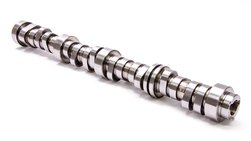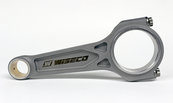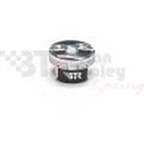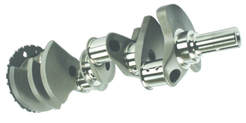Diet & Exercise: Get Fit!Page 4: Good news, Bad news. It looks like you're starting to fit in around here, You're now part of a life filled with automotive happiness and empty pockets.
If you've already bought and installed something from all of the previous pages and you still want more power, you're likely going to need to go deeper into the thing that converts gasoline into horsepower. In other words, you need to start replacing internal engine components.
There are multiple avenues to take, not one or all of them are right or wrong. It's down to preference and what's most efficient for accomplishing your goals. Any of the options below will require you to get an aftermarket tune or at the very least, make some pulls on a Dyno to monitor your Air/Fuel Ratio's(AFR's for short). If you're flowing more air than your calibration is able to account for, you'll run lean and that's when you need to start worrying about permanent engine damage. 1. Ported and performance heads. 2. Aftermarket cams. 3. Forged pistons, connecting rods and cranks. 4. Stroking/de-stroking, Boring, and Sleeving. X. I hope it goes without saying, if you're at this point in the game, you should definitely be considering aftermarket/performance studs to make sure the engine stays together at max output levels. Engine Modifications: Ported and Performance Heads
Back in the day, you could swap out heads in about 1/2 hour. If you're a bad-ass with modern Chevy's, maybe you can still do that, but most of us common folk aren't ninja's like that! Nevertheless, they're still swap-able and they can free up power just like they used to. Casting technology and processes have gotten better since the 60's-70's, but depending on the manufacturer, they may still be quite restrictive even for modern vehicles.
So for cylinder heads, there's a couple things that can be done. 1. Port the intake and exhaust ports. This entails opening and/or tuning the ports to maximize the flow of intake air and exhaust gasses. This may also include matching the ports to the exhaust manifold/headers and/or the intake manifold runners. 2. Milling the head. This process is largely about changing, usually increasing, the Compression Ratio. A rough explanation of this is that the head is removed, the bottom surface of the head is machined down a small amount, and the head is reinstalled with a smaller effective combustion chamber volume. 3. Valves. The other major thing that can be done is enlarging the intake and exhaust valves to permit better airflow. Again, the head has to come off and all the internals need to be removed. The valves are removed and the mating surfaces are machined to match the new enlarged valves. I feel like this is slightly less common in the past decades, but still holds value if the valves are proving to be a bottleneck on your specific application. If anything like this is of interest to you, here are some of your options: (Since all of these mods are really dependent on your vendor and more importantly your application, I am not even going to try to document cost or power gains as they will vary from one scenario to the next.) PRAY Performance Yes, I've mentioned him before, with good reason. He's been doing work for the 6th Gen Camaro community since it debuted and his customers have nothing but good things to say what he does. Check the forums to see some of his reported gains on the dyno. The cost associated with his service is an awesome value and will definitely give you an edge over a stock car. (Or if you're a Mod-Addict, it'll help you squeeze a bit more power out of your existing mods.) Contact this guy if you want to do some Intake and Exhaust porting, especially if you want to match your intake manifold to your heads. He can do all that for you and more! Texas Speed & Performance If you're looking for some performance heads that will give you performance and reliability, Texas Speed & Performance has an option for you. Mind you, this company has a great reputation and therefore has some leverage on the industry in terms of cost, but they have a valuable product and they know it. That being said, these heads are CNC ported so they will be very consistent part to part. This is good and bad for a couple reasons. One, you're not likely to get a part that makes a lot less power than someone else that bought the same configuration, because the parts will be the same so long as they were fixtured properly. The bad thing is that there's not necessarily a personal touch placed on every part which may give you an advantage over the competition. On top of that, because the parts are primarily worked by a machine, subtle imperfections could be overlooked since a professional isn't looking at every little detail of what's being done. This is my opinion, so feel free to disagree with me about it. I understand that even hand-ported parts will have mistakes from time to time depending on how the person is feeling or how distracted they are. Nevertheless, Texas Speed & Performance has the ability to give you whatever head you need for your application, and it WILL work. It just might not be as cost effective as other alternatives. It's a Risk VS Reward decision. One really good thing about them is that they give you the option to buy them outright without a core. This is really helpful for going back to stock afterwards and having your original parts. Lingenfelter CNC Ported Heads Although not quite as configurable as the TS&P heads listed above, they offer a mild improvement over the stock heads and they have a reasonable price tag from such a reputable company. They also give you the option of buying the heads outright, or buying them and returning your stock heads as a core. They seem largely focused increasing the operating RPM range by using lightened components and more aggressive valve-springs. Also, I like the fact that they are essentially duplicating a hand-ported head profile for the ones that are produced, AND they have a quality control process which consists of random inspections via section cuts to ensure cross-sectional thickness. This helps to make sure you're not getting a head with a paper thin wall that cracks, or worse yet, separates and gets into your combustion chamber(not likely). Just visually judging by the size of the ports on this head versus other heads, the porting doesn't seem to be very aggressive. That's not a bad thing depending on what your supporting mods are and what your performance targets are. Tony Mamo - Mamo Motorsports Mamo Motorsports can port, machine, mill, and otherwise work magic on your heads and related components with his thousands of hours of experience on the related benches. I don't know how readily available he is to work on your parts, but the wait is worth the reward. Keep him in mind if you want to get a throttle body, intake manifold, and heads ported in one fell-swoop. If he's too backed up and you don't want to wait for him, PRAY is still a great option as well. Check out some of the images on his website to see what he's done in the past. It's nothing short of impressive. |
|
Engine Modifications: Aftermarket and Custom-Grind CamsDue to the complexity of changing the Cam in the 6th Gen Camaro, this is one mod you want to make sure is right the first time so you don't have to go in there again. due to this, you need to do your research and pick a supplier that has a great reputation and gives you the attention and support you need BEFORE you spend any money with them. If they're not helping you before you spend money with them, don't count on them caring about you after you give them your money. Any company that does custom grinds should be able to tell you what you need and why you need it. If they're not able to tell you specs and where they land in a range of mild to wild and how it effects your driving experience, you shouldn't be spending your money with them. End Rant!
COMP Cams 624-500-13 AFM Cam Cost: $411.50 Designed to be an upgrade for a pretty much stock engine, this cam can give you performance gains throughout the RPM range while retaining a smooth idle and excellent slow speed driving characteristics. As noted by COMP Cams on their website, this is an ideal replacement cam for L83 and L86 truck engines. COMP Cams 624-512-13 AFM Cam Cost: $477.44 As a step up from the 624-500-13, the '512 is aimed more towards increasing responsiveness and mid-range power. This cam is also a great option for L83 and L86 truck engines, but could also be suitable for a daily driven car that isn't intended to spend a lot of time at a track. Detailed specs are also available on COMP Cams website. COMP Cams 624-524-13 AFM Cam Cost: $455.68 Stepping up even further is the '524 of this line-up, marking a good gain for a slightly modified engine. This came is more towards the high side of a mild cam but should still provide large improvements in performance without sacrificing much in terms of slow speed drive-ability. This is likely to be the level of cam I'd go with as I plan to daily drive my car for years to come. COMP Cams 624-536-13 AFM Cam Cost: $487.15 The '536 is a big step up from the '500. Based on the numbers on COMP Cams website, this looks to be more of a race oriented cam which will likely suffer some deteriorated slow speed driving characteristics, but massive improvements on the top end. This is the cam to go with if you're building a drag-strip-only motor. Or if you're willing to put up with the drive-ability traits of this cam and want the biggest cam gains possible, this could be the one for you. COMP Cams 224-000-13 Non-AFM Cam (Custom Grind) Cost: $437.93 If you're willing to give up Active-Fuel-Management (AFM), and you're wanting to do something custom for your build, COMP Cams offers custom grinds to get you where you need to go. For services like this, you'll need to contact them directly to discuss the specs, details, and goals for the cam. You can find that page HERE. As stated on COMP Cams' website, deleting AFM allows you to achieve higher overall valve lift. COMP Cams Sportsman Tool Steel Cam Cost: $varies. Finally, also from COMP Cams is the Tool Steel series cams for the LT1. The purpose of going with this style cam is to run a more aggressive Fuel Lobe than you otherwise could on the standard COMP Cams materials. Based on the info available on their website, you can flow up to 70%+ fuel just from the fuel lobe upgrade. General Note: All images are courtesy of COMP Cams and/or Amazon.com |
|
Lingenfelter GT30 Cam
Cost: $539.95 This is the only DOD and AFM compatible Lingenfelter cam commercially available for the LT1. As stated on Lingenfelter's website, this cam is suggested for normally aspirated engine applications with stock cubic inch, or larger cubic inch applications desiring a non-aggressive idle. Lingenfelter GT31 Cam Cost: $539.95 This cam and the remaining cams from Lingenfelter require a DOD delete kit to be installed which I consider to be irreversible without signs of the work being done. That being said, this is the entry level cam for Forced Induction builds with factory-like drive-ability. Muscle-car sound with a non-aggressive idle. Lingenfelter GT32 Cam Cost: $539.95 Like above, this cam requires a DOD delete kit to run in your LT1. This cam is for a Naturally Aspirated, or N/A, build with an aggressive idle yet reasonable low speed driveability. Specs are shown on Lingenfelter's website HERE. Lingenfelter GT34 Cam Cost: $539.95 Got boost and want lope? This is what you want. From my understanding of how Cam specs work, this is the cam you want if you're running entry levels of boost. (<1 bar) This will allow you to make better use of the same levels of boost. Meaning, you can flow more air and don't have to upgrade pulleys or waste-gate springs, or worse, upgrading a very expensive dual ceramic ball-bearing turbo. Specs are shown on Lingenfelter's website HERE. Lingenfelter GT35 Cam Cost: $539.95 This is the Cam that you want if you're running higher levels of boost and you want the best performance you can get. The intake lift is less than the GT35 which reduces unnecessary wear at the higher levels of boost and yet it has higher levels of lift for the exhaust valves, helping you to get the exhaust gas out as quickly and efficiently as possible. Specs on Lingenfelter's website HERE. |
Engine Modifications: Pistons, Connecting Rods, and CranksTypically, when you're this far into the modifications, you are buying parts that need to be custom machined/built for your application. Therefore, rather than pointing out specific pistons, I will point out manufacturers that can be contacted to support your build. Connecting rods are a bit different as they come in different lengths, weights, and strengths. This Article here from SuperChevy goes over a lot of the stock engine specs.
Connecting Rods Connecting rods are one of the most crucial parts of your build when trying to go above and beyond what the OEM's protected for. Yes they may have forgings and yes they may be shaped a certain way. Again, the thing to keep in mind is that these engines weren't built like Supra engines were back in the day. Every component is optimized to operate near it's limit with a pre-determined safety net to hedge their risks for Warranty work. Connecting Rods are no exception. Therefore, if you plan to go 30%-40% over what the engine was originally intended to produce, an upgrade to your connecting rods is not a bad idea. ESPECIALLY if you plan to raise your Rev limiter. Let's see what's available for the GENV LT1. If you want to replace your factory rods with something stronger, you'll want them to have a center to center distance of 5.700" or 144.78mm. Chevy performance rods can be found HERE. Also, Here is a great site that explains a bit about how to choose which Connecting Rods for your application. Manley Forged Steel I-Beam Connecting Rods 5.700" These Rods are a great upgrade to your build if you're keeping the stock stroke and rod length. I-Beams are great for high-power, high-RPM applications such as racing and drifting. In most instances, these are also lighter than H-Beam Rods. Use these for your race car, not your towing rig. Manley Forged Steel H-Beam Connecting Rods 5.700" These are also for stock stroke and rod length setups. From my understanding, these rods are better suited for a high torque engine that lives in the lower RPM range. in other words, use these for your towing rig, not your race car. Wiseco Shorter-stroke 6.125" BoostLine Connecting Rods Wiseco has a connecting rod from it's LS line-up that will fit the LT1. Its quite long, so it's aimed more towards a shorter stroke, high revving engine. You CANNOT use these with your stock crank and pistons. These rods look to be built with some serious power in mind though. They claim to have a 60% increase in bending strength over H-Beam Rods. Pistons Stock compression ratio for our Gen V LT1 Engines is 11.5:1 and the stock Bore is 4.065" or 103.25mm. This should help you a little bit with your piston selection. One important note to keep in mind, the components from LS-Based engines are not compatible as the intake and exhaust valves are reversed in these engines compared to the LT1's. A side note for those that don't know what Gas Ports on Pistons are: This article from Reher Morrison is very informative! Brian Tooley Racing (Bardstown, Kentucky) Pistons by Brian Tooley Racing are one of the most accessible pistons for our application. Furthermore, they are every bit as good as any other piston manufacturer out there. BTR makes pistons for stock stroke, long stroke, short stroke, and stock stroke with longer rods. (I'm sure they're readily able to make any custom piston at a moment's notice as well.) If you're considering custom pistons or your wanting to upgrade your factory hardware, you should give BTR serious consideration. A couple specific examples of their piston options for us that maintain stock rod and crank geometry are pointed out below. Brian Tooley 800BTR These will give you a minor bump in your Compression Ratio. Good for N/A. Brian Tooley 801 BTR These will give you a decent drop in your Compression Ratio. Good for Boost. JE Pistons (Cypress, California) Of all of the piston manufacturers listed, JE has the largest number of options listed on their website. Unfortunately, it looks like all of them will require aftermarket connecting rods. This is a plus and a minus, however. If you're already in there, it makes sense that you'd also be upgrading your rods to something stronger as well. In doing so, there can be advantages to increasing the length of your rods and essentially moving the wrist pin further up in the piston but maintaining the same stroke. More info on that can be read HERE. Wiseco (Mentor, Ohio) Their catalog can be found HERE. This is one of the companies that I must say is stuck in the old days on certain things. Take a look at their website and try to find a specific part, Nope. Refer to the catalog. That's the only way you can find out specs of their pistons. That's why I have it referenced as the first sentence in their section. All the grumping aside, they make great products and have a good reputation. A couple specific examples of their piston options for us that maintain stock rod and crank geometry are pointed out below. Wiseco 800BTR These will give you a minor bump in your Compression Ratio. Good for N/A. Wiseco 801 BTR These will give you a decent drop in your Compression Ratio. Good for Boost. Mahle (Farmington Hills, Michigan) Their catalog can be found HERE. Another company that makes great products yet has a somewhat lousy site to search for their products. They have a few different options for our application, but if you're considering them for your build, I would consult a professional engine builder(or Mahle themselves) for confirmation before pulling the trigger on something. Others Since there's several other companies out there that are completely capable of producing pistons for this application, and possibly already do, I want to list them below so you can reach out to them to see if they make something for us. (This is just for people that have heard of them or want to work with a specific name brand.) Arias Pistons (Gardena, California) CP-Carrillo Pistons (Irvine, California) <-- Owned by Pankl Racing, So you know they're good Diamond Racing Pistons (Clinton, Michigan) Gibtec Pistons (Denver, Colorado) RaceTec Pistons (Huntington Beach, California) Ross Racing Pistons (El Segundo, California) Supertech Pistons (San Jose, California) Crank Shafts If you're wondering, do I need long snout or short snout, the answer is in another question. Do you have a dry sump or wet sump? If you have a dry sump, you need the long snout crank. If you have a wet sump, you need the short snout. The LT1 in our Gen 6 Camaro's will have Wet Sump cranks or Short Snout Cranks. The Stock Stroke on the Gen V LT1 is 3.62" or 92mm. Callies Magnum 4.000" Stroke Crankshaft Callies is allowing you to play Little Red RidingHood as they provide 3 different lengths of stroke on their Stroker Cranks. This 4.000" is the shortest Stroke of the 3. I would expect this to have slightly increased overall capacity compared to the stock crank. Callies Magnum 4.100" Stroke Crankshaft If you're not wanting to stroke as far as you can for some reason, this "In-Between" solution from Callies is a good option. This crank, along with the others from the Callies Magnum Series, feature a Perma Case Deep Nitride Heat Treatment to ensure the best performance and durability. Callies Magnum 4.125" Stroke Crankshaft This is the longest stroke available for you from Callies. This is what you want if you want to get the most low end power possible from your LT1. This is not the crank I would buy if you're trying to build a 9000RPM screamer that doesn't have upgraded piston skirts. The Piston to cylinderwall relative speeds will be significantly higher than the stock materials were intended to endure. Lunati Signature Series Gen V LT1 4.000" Stroke Crankshaft 65540001 52lbs This Crank from Lunati will give you a 4.000" stroke compared to a 3.622" stock stroke. Therefore you will need shorter Rods or a shorter compression-height piston. I'm only including links for the Wet Sump / Short Snout because our Camaro's don't come with the Dry Sump system like the Grand Sport Corvette does. Check eBay for that part number before you buy one of these cranks though, they can be much less expensive on there from time to time like seen HERE. Lunati Signature Series Gen V LT1 4.125" Stroke Crankshaft 65541251 52lbs This Crank will give you an even longer stroke of 4.125" compared to a 3.622" stock stroke. Again, you will need shorter Rods and most likely a shorter compression-height piston. They also have Dry Sump versions of this crank as do the majority of the rest of the suppliers. Manley Lightweight Series 194158 3.622" Stroke 51-53lbs This is a great crank from Manley which will pretty much serve as a strengthened replacement to the stock crank. Also comes with the appropriate 58 tooth Reluctor Wheel. As noted by Jegs: "The stock timing crank gear may need to be chamfered to clear the larger radius on the snout of the crankshaft." Manley Lightweight Series 194258 4.000" Stroke 51-53lbs If you're wanting to stick with Manley and you want to make a stroker, they've got you covered as well. This crank bumps the stroke up from 3.622" to 4.000" like other manufacturers are doing. Though they might not be a significant weight savings over the stock cranks, they are expected to be stronger than factory. Do you know of anyone whose broken a stock crank as a result of too much power? Texas Speed & Performance 4.000" Stroke Crank 52lbs This crank from Texas Speed & Performance is stated to be good up to 950HP. It has an increased stroke of 4.000" and requires different rods and/or pistons to use it. At this price, it is an excellent value and definitely worth consideration if you're building your motor. |
Engine Modifications: Stroking or
|
|


































